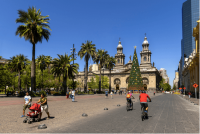The Argentinian nation has four main symbols: the flag, the national anthem, the coat of arms, and the rosette. Let us see what each of them represents.
Key Information about the Argentinian Flag
The Argentinian flag is made up by three horizontal stripes, light blue on the top and bottom, and white with a golden sun in the center. The most common dimensions used are 140 by 90 centimeters.
Origin
The Argentinian flag was established on February 27th, 1812. General Manuel Belgrano is accredited for its design, and its colors are inspired by the rosette. The following year, the Sun of May also became part of the Argentinian.
Argentinian Flag and Mythology: The Inti God
The Argentinian flag is one of the country’s icons. With a tradition of over 200 years, it shares some symbols with other South American countries. The main one is the Inca god Inti found in its center (and also on the coat of arms). It is the Sun of May, which also appears on the Uruguayan flag. Representing the Inca god Inti (a solar divinity), it reminds us of the origins of the Argentinian people. All the peoples from the Andes share references to this deity.
The solar disc representing the sun has a human face and is surrounded by 32 rays, alternating straight and curved shapes. In the Incan mythology, the sun descended from the sky into the ocean every night. A male figure, it was Pachamama’s (Mother Earth) husband, though sometimes the Moon Goddess, Mama Quilla, was also considered his wife and/or sister.
The Argentinian National Anthem
Its current version was established in 1900. Lyrics were written by the Argentinian politician Vicente López y Planes, the president of the country for a few weeks between July 7th and August 18th, 1827.
Coat of Arms
The Argentinian coat of arms shares the colors of the flag and was established in 1813. In the center, it boasts a blue and white oval, and a shovel holding a Phrygian cap. Two hands are held together in front of it, and the oval is surrounded by two sprigs. All of the above is crowned by the Sun of May on top.
The Argentinian Rosette
The Argentinian Rosette was created during the revolution of May, 1810. Manuel Belgrano, one of the leaders of the war of independence, distributed blue and white rosettes among his troops. The rosettes were originally red, the same color used by the royalist army, so Belgrano changed the colors in order to avoid confusions.
No comments yet
There are no comments on this post yet.






Leave a comment